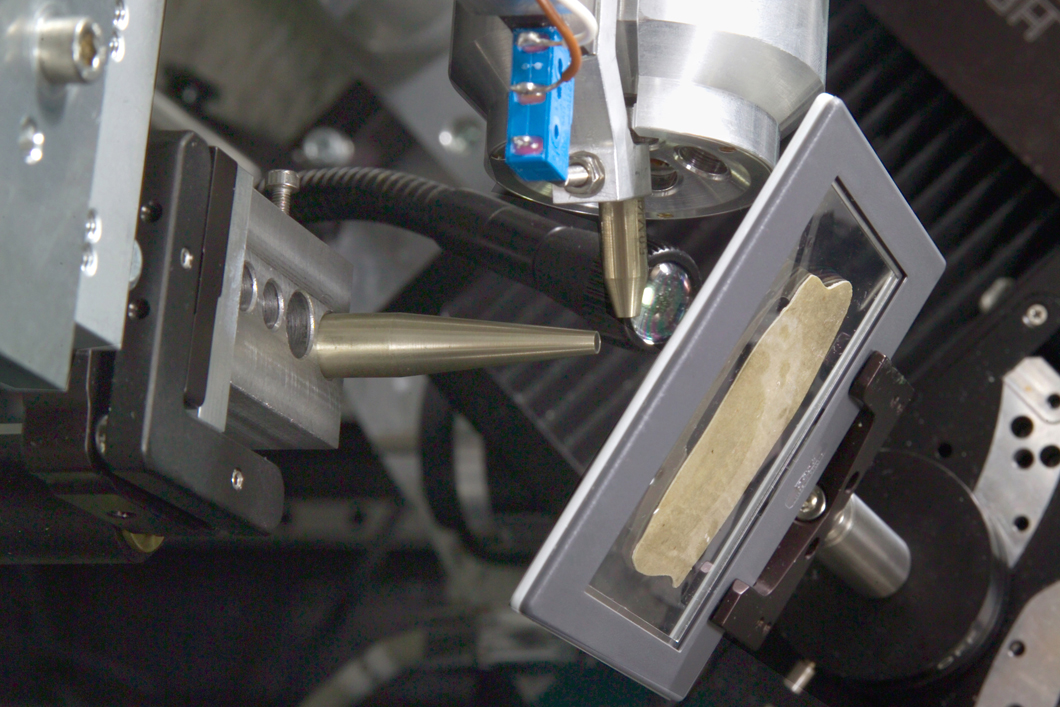
Fragments of the Dead Sea Scrolls that were studied at BAM between 2006 and 2010.
Source: BAM
On 22 October 2018, the Museum of the Bible announced the results of the analysis of its five Dead Sea Scrolls fragments. At the request of the museum, the Bundesanstalt für Materialforschung und -prüfung (BAM) conducted a battery of tests on the fragments. BAM’s results show that the five fragments have material characteristics inconsistent with fragments whose origins are certain.
BAM has extensive expertise in the analysis of artefacts and cultural assets. This includes the non-destructive material analysis of dyes, writing & drawing materials, and organic writing substrates.
Why did BAM conduct this analysis?
In April 2017, BAM received an analysis request from the Museum of the Bible, Washington D.C. Prof. Dr. Ira Rabin from the Analysis of Artefacts and Cultural Assets division at BAM led the examination of five fragments reportedly associated with the Dead Sea Scrolls.
BAM recently sent its report of findings to the client. Details of the report need to be requested from the client.
Who led the testing of the fragments of the scrolls at BAM?
Prof. Dr. Ira Rabin, scientist at BAM (and Prof. at Universität Hamburg) and Prof. Dr. Oliver Hahn, head of the Analysis of Artefacts and Cultural Assets division at BAM (and Prof. at Universität Hamburg).
Which tests were conducted?
Since this was commissioned research that included a confidentiality agreement, we have to refer interested people to the Museum of the Bible.
During the testing of Dead Sea Scrolls between 2006 and 2010, BAM, for example, we used several non-destructive testing methods to determine the composition of the inks and the parchment.
What was the goal of the tests?
Generally, tests try to determine if existing samples show any similarities to comparative samples.
What led to the conclusion that some of the fragments were forgeries?
This term does not fit from a materials research point of view. As mentioned before, it’s all about a comparative analysis.
Is it possible to say how old the forgeries are or from which period they come?
This question was not the focus of the tests and therefore cannot be answered.
Why did the Museum of the Bible enlist BAM for the tests?
Prof. Dr. Oliver Hahn: “BAM has decades of experience and the necessary expertise to conduct such tests. For example, as part of a research project, we extensively studied fragments of the Dead Sea Scrolls between 2006 and 2010 within the frame of a dedicated research project.”
How is it possible to detect a forgery?
The following applies generally for the analysis of artefacts and cultural assets: “Scientific analysis can detect forgeries if materials were used that only existed after the supposed original was created. If substances were used whose contemporaneous use is known, it is virtually impossible to prove a forgery from a material science point of view,” explains Prof. Dr. Ira Rabin, from the Analysis of Artefacts and Cultural Assets division.
Background Information about the analysis of artefacts and cultural assets at BAM
The development and adaptation of non-destructive analytical methods makes them extremely valuable to extensively characterise the material composition of artefacts and cultural assets. Scientific material analysis methods provide important clues for answering historical and cultural questions that cannot be solved using the methods of the humanities alone.
In addition, it is often necessary to characterise environmental material damage in order to create suitable restoration or conservation strategies. The provision of support in natural science-related matters in restoring and conserving such assets is the main focus of the work of the Analysis of Artefacts and Cultural Assets division.
About the Dead Sea Scrolls
The Dead Sea Scrolls (also Qumran Caves Scrolls) are ancient Jewish religious, mostly Hebrew, manuscripts found in the Qumran Caves in the West Bank near the Dead Sea.


